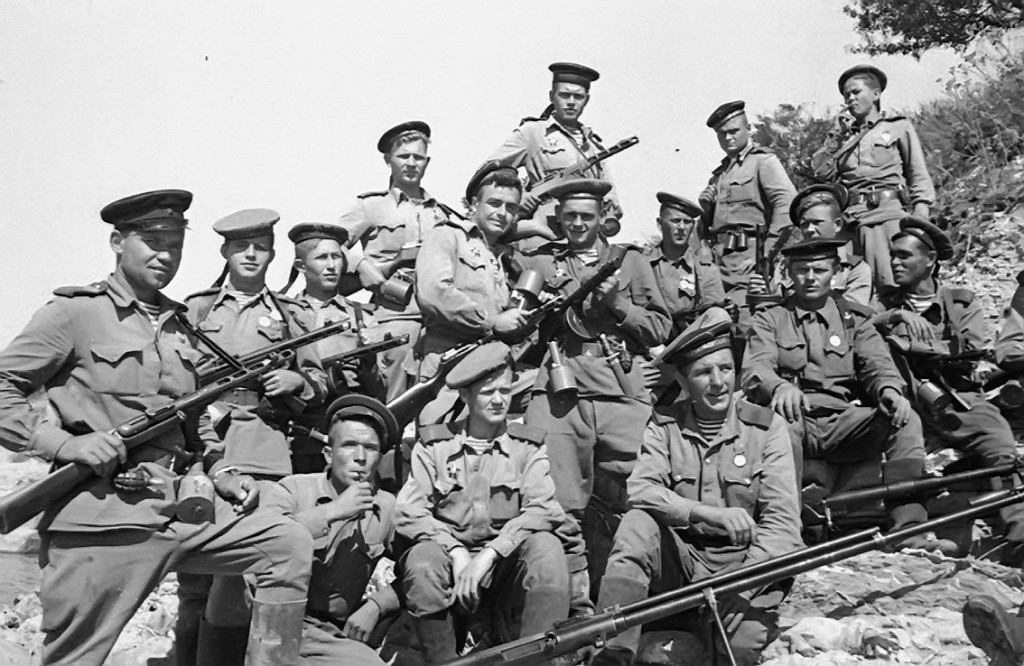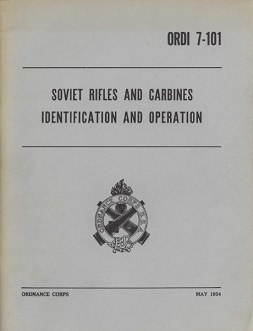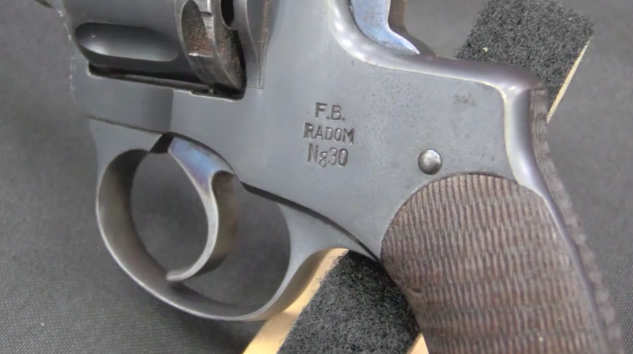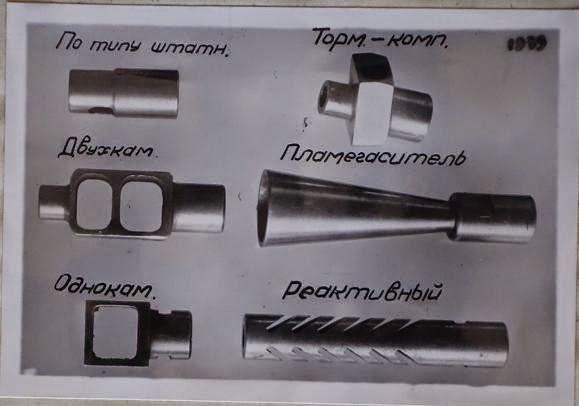Two followups for you today, courtesy of readers who ferreted out some addition material for me – thanks guys!
First, my vintage photo of the Soviet marine snipers generated a bunch of discussion of the Soviet marine troops, and Ruy sent me this photo of a Marine landing party wearing the rare “land” uniform (you can see the striped naval shirts peeking out at the neckline). Note in particular the khaki covers worn over the naval headgear. This particular unit belongs to a naval assault battalion led be a Major Caesar Kunikov, and the photo was taken in the coastal town of Gelenzhik – an important supply depot which was near the front-line in 1942-43 and not far from Novorossiysk.

Staying on the Soviet theme, we also have a manual to share, thanks to Juul. You may recall that I posted a part of a 1954 US-made manual on Soviet semiauto rifles a little while back. I didn’t have a copy of the complete document, but Juul found one – so here you go. In addition to the SVT/AVT family, this also covers the various Mosin-Nagant rifles and carbines (including the very rare 1910 carbine):





Nice, they have both a PTRD and PTRS-41 as anti-tank rifles.
This is great — nice work, Ruy, Juul and Ian! The quality and resolution of the photograph is very good ; the photographer really knew what he / she was doing.
THANKS for the manual. I recently purchased a Mosin so having it will be a big help.
Very interesting, and thanks very much for the great manual! I’ve got the U.S. Mosin-Nagant manual from World War I: “7.62mm magazine rifle, model of 1916” and the “Tokorov” SVT-40 version from the 1950s…
Thanks very, very much Ruy, Juul and Ian.
Following up on Mu’s comment: Given the sheer numbers of anti-tank grenades and the PTRS-41 and PTRD 14.5mm anti-tank rifles in the foreground, do these guys represent some kind of “tank killer” or anti-vehicle squad? Looks like to a man they’ve all got Shpagin PPSh41 smgs too…
From distant past I recall the Russians had use of troops they called “dessant” (meaning deployment units) but they were not thought of as an equivalent of U.S. Marines, for example. They did not have independent command in that sense.
This is nice picture showing hardy looking and well equipped unit. It proves they were able and ready to engage armoured vehicles (also looking at grenades). I am sure they were good match for invading Germans. Thanks for posting!
One general note which comes cross my mind (and if fact it did on couple occasions): we cannot really tell for certain that these pictures are from true war situation. They may be also war movies takes. Only person who was in action at that period of time would be able to discern. There were tons of them made, mostly for shaping up public’s mind.
Hmmm… I don’t think so, Denny. The photo was indeed taken at the place mentioned, in 1943. Maybe a propaganda shot, but not from a movie, I think. For the Soviet public, it would have been easier to associate a naval landing party with the archtypical “black death” uniform, which not the case here.
Hard to tell Ruy. Om my part, given my time and place of origin, I have seen quite a bit. What I am saying is reflection of that.
I do not want to go into general talk on psychology of images vs. reality, but you may know yourself there is quite a bit to it. You do not necessarily need to call it “propaganda”. It may be just sublime ‘mind conditioning. Have seen it, been there.
I agree Denny, and also acknowledge the fact that you speak with the benefit of personal experience. However, I am still convinced that this a period photo, as per several clues present in the photo itself, and not just the atypical – or rather seldom seem – uniform (including those very rare khaki covers worn over the sailor caps of some men), but also the kit; I also think that the early type PPSh 41s, with their rifle-style tangent sights, as Leszek noted below, might point towards that.
Well, one thing that’s obvious is that this is not your typical fighting unit. The average age is way to high, these look like in their 30’s. So it doesn’t seem to be all NCOs, a lot of blank shoulder pieces. What makes me wonder if these are Naval yard workers used as ground troops, or at least dressed up like it.
Btw, they also wearing M1935 tunics (gimnastyerka, as the Russians themselves called their unique tunics, fashioned in Tsarist times after a traditional shirt style), with stand and fall collar, but of a seldom seen type, with hidden buttons. The sole exceptions seems to be the tunic worn by the sailor at the extreme right, front row.
Extremely good knowledge of military attire, Ruy! And I am also impressed with proper term in Russian. All seem to fit your version.
This picture gives real meaning to “hard core”! They exude confidence in that they know exactly what it is all about.
This was perhaps a kind of “After the Battle” photo – note neatness of their uniforms. Also note that most, if not all Papashas (PPSh 41 SMGs) are of the older model, with tangent sights rather than the ubiquitous flip-over sight of the later variation. Another thing – have anyone else of you noticed a conspicuous lack of rifles? They only have Papashas and ATRs, not a single rifle, no light machine gun, but instead shitload of hand grenades of at least three types: offensive RG-42 (second from the left, top row), defensive F-1s and anti-tank RPG-40s. Judging from the precarious position of the “lemon” hanging for dear life from the belt of the NCO at extreme left these are early F-1s with a dreaded Koveshnikov fuze, which probably killed an equal amount of people on both sides of the front. The Koveshnikov fuze had a handle conforming the ogive of the grenade with two nicks in it, the lower of which caught the D-ring at the belt to keep the grenade in such position. The later, much safer UZRG fuze introduced with the RG-42 in 1942 had a typical pivoting lever which lower part was flat, and the grenade would just drop from the belt if hung in that position. The nicks or notches in the Koveshnikov handle were made to assist fingers in keeping it down against forceful spring after the cotter pin was withdrawn. When thrown, the fuze cap with the handle was flinged up, catapulted off the grenade by the spring, releasing the internal striker to fire the cap and the initiate the delay. These fuzes were famous for treacherous traits, and after taking the cotter off, they often slipped from soldier’s grab, initiating the black powder delay without a conscious release of the handle by the soldier, leading to many accidents. Also, the practice of hanging them by the handle from wherever the soldier was able to find a suitable ring resulted in accidents. But, hell, war is a risky business…
Thanks for the detailed note, Leszek. I believe we all noticed the absence of rifles. You are absolutely right about the abundance of hand grenades. Your detailed description of the F-1 defensive grenande and its, ahem… early, problematic fuse is most welcome. Thanks again!
A note on the use of the striped naval “telnyashka”; while originally used to denote Navy personnel, their modern use is color-coded to their respective branch. Light blue (representing sky) for paratroopers, dark blue (representing sea) for Navy, light green (representing forest) for border troops, black (representing the deep) for submariners, and red (I can only imagine what red represents) for OMON and MVD.
I’m sure someone will be along to correct me if I have erred.
thanks
Awesome! Full content and discernible pictures. Fantastic!
The Soviet coller codes, are not so distinktiv. All branches uses a camo overall and a helmet, so in combat they will seem almost alike
Peter,
Yes, only a small portion of the shirt is visible, as in the above photo. It is my understanding that they are considered a source of personal pride for the wearer, and a sort of symbol of masculinity.
Of course, I am just repeating what I have read. I have never been to Russia, nor do I have any close Russian acquaintances.
Did the Soviets have a Marine Corps per se in WW2? I’ve read during the siege of Stalingrad a lot of sailors stationed at Valdistock (where they were mostly just keeping an eye on the Japanese, who the USSR didn’t declare war on until near the end) volunteered to go to Stalingrad (loooong train ride) and were allowed to wear their striped jumpers under their uniforms. Incidentally, my original source on this was David L. Robbins’ “War of the Rats” which is – like all of Robbins’ WW2 novels – incredibly well researched but I’ve seen historical references that back it up.
Excellent site merci
well, monetizing websites and stuffs should be great. making money on the internet is a great way to earn money“
The photo-voltaic panels collect solar energy, convert it into electrical power, and store it in battery cells somewhere within the home.
Many of those free energy generators are actually built worldwide by individuals that rely on them to drastically reduce their energy bills as well as completely eliminate
them with respect to the scale of implementation. However while many alternative energy
choices only really suitable for giant scale generation,
wind turbines have become successful when reduced to some size suited to home wind power and so are capable of making a big contribution in your household’s electricity requirements.
The Positive Effects of Reiki about the Human Body
Reiki is known for its positive results about the human body.
However, many individuals of those who never have yet experienced its power determine what exactly Reiki does and
what its results are. If you are thinking about the best way Reiki will help you, then read on to see what Reiki are able to do for your body, mind and soul.
1. Increases the body’s capability to heal itself. Normally, your body carries a defense system which functions good provided
that the Ki flow is just not interrupted. When the Ki
is not really in a position to flow through our bodies, illnesses and diseases can be shown.
Reiki stimulates the flow of positive energy, thus enabling
one’s body to heal itself and fight the internal
and external attacks more efficiently.
2. Cleans the body coming from all toxins. Because it acts around the system, it can be one of the few complete
detox programs you can follow. In addition to that
it does not involve refraining from food or another
kind of activity. Yet, mental poison need to be banned from your individual’s mind because
they may have a negative impact upon the procedure.
3. Promotes health, positive thoughts and relaxation. The principles of Reiki rely on positive thinking, thus a peace of mind and relaxation is induced towards the individual.
By removing negative energy and promoting feeling of
peace, the healing process will probably be easier and
shorter, whatever the illness or disease where the individual
suffers.
4. Works on the digestive tract and raises the benefic outcomes of every thing an individual
ingests, from food and water to medicines and curative herbs.
Thus, it could be used successfully as a complementary therapy for all those already taking medicine,
but as well it is perfect for maintain the person’s health in good parameters.
5. Works on personal feelings, helping people conquer negative experiences from
other lives and handling unexpected or unpleasant situations off their lives.
People with depressions, anxieties or struggling with stress can see dramatic improvements with their conditions after the Reiki sessions.
6. Makes the transition from life to death much easier.
It helps the soul transcend into immortality and one’s body
feel less struggling with this transformation. This is why many Reiki adepts utilize Ki to
make their transition from world to a different smoother.
Reiki offers healing for all kinds of bodily
conditions, as well as the spiritual problems.
It is like a best ally for all those people short of funds, however
it can also relieve healthy people from quotidian stress and problems.
You can see more details here on website : http://reiki-master.cf/
Here we are here to look for information that can make us gain insight. thank you for this good article . cara menggugurkan kandungan